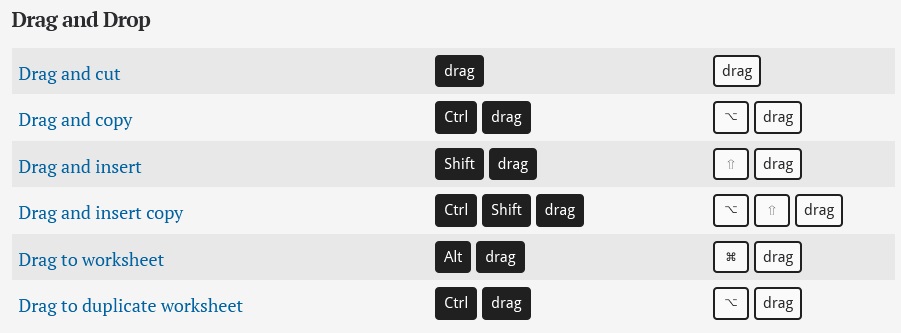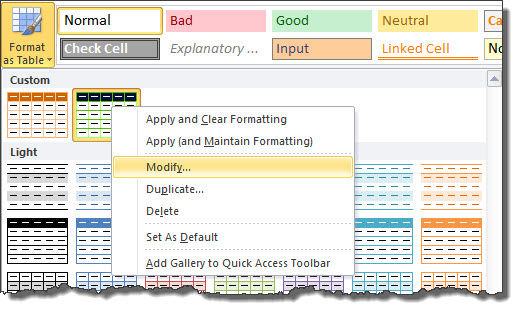
Excel 2019 makes it simple to create a new pivot table using a data list selected in your worksheet with its Quick Analysis tool. To preview various types of pivot tables that Excel can create for you on the spot using the entries in a data list that you have open in an Excel worksheet, simply follow these steps:
- Select all the data (including the column headings) in your data list as a cell range in the worksheet.
If you’ve assigned a range name to the data list, you can select the column headings and all the data records in one operation simply by choosing the data list’s name from the Name box drop-down menu.
- Click the Quick Analysis tool that appears right below the lower-right corner of the current cell selection.
Doing this opens the palette of Quick Analysis options with the initial Formatting tab selected and its various conditional formatting options displayed. - Click the Tables tab at the top of the Quick Analysis options palette.
Excel selects the Tables tab and displays its Table and PivotTable option buttons. The Table button previews how the selected data would appear formatted as a table. The other PivotTable buttons preview the various types of pivot tables that can be created from the selected data. - To preview each pivot table that Excel 2019 can create for your data, highlight its PivotTable button in the Quick Analysis palette.
As you highlight each PivotTable button in the options palette, Excel’s Live Preview feature displays a thumbnail of a pivot table that can be created using your table data. This thumbnail appears above the Quick Analysis options palette for as long as the mouse or Touch pointer is over its corresponding button. - When a preview of the pivot table you want to create appears, click its button in the Quick Analysis options palette to create it.
Excel 2019 then creates the previewed pivot table on a new worksheet that is inserted at the beginning of the current workbook. This new worksheet containing the pivot table is active so that you can immediately rename and relocate the sheet as well as edit the new pivot table, if you wish.
In Excel 2008 for Mac: Pivot Tables for Data Analysis, Microsoft Most Valuable Professional Curt Frye helps dispel the common fear of the Pivot Table feature, demonstrating how to use this powerful tool to discover valuable business intelligence.Curt shows how to create Pivot Table reports from internal Excel data and outside data sources, use filters to focus on the most important data in the. This Excel tutorial explains how to refresh a pivot table in Excel 2011 for Mac (with screenshots and step-by-step instructions). See solution in other versions of Excel: Excel 2016. Question: How do I create a pivot table in Microsoft Excel 2011 for Mac? Answer: In this example, the data for the pivot table resides on Sheet1. Highlight the cell where you'd like to see the pivot table. In this example, we've selected cell A1 on Sheet2. Next, select the Data tab from the toolbar at the top of the screen. Click on the PivotTable button and select Create Manual PivotTable. Before you get started: Your data should be organized in a tabular format, and not have any blank rows or columns. Ideally, you can use an Excel table like in our example above. Tables are a great PivotTable data source, because rows added to a table are automatically included in the PivotTable when you refresh the data, and any new columns will be included in the PivotTable Fields List. Pivot Table with Multiple Sheets (Table of Content) Pivot Table with Multiple Sheets; How to Create Pivot Table from Multiple Sheets in Excel? Pivot Table with Multiple Sheets. Most of you know about the pivot tables, it is a very useful tool to get all your data consolidated in one table and get the figures for particular things as required.
The following figures show you how this procedure works. In the first figure, the fourth suggested PivotTable button in the Quick Analysis tool’s option palette is highlighted. The previewed table in the thumbnail displayed above the palette shows the salaries subtotals and grand totals in the Employee Data list organized whether or not the employees participate in profit sharing (Yes or No).
Excel For Mac Pivot Tables Free
The second figure shows you the pivot table that Excel created when I clicked the highlighted button in the options palette in the preceding figure. Note this pivot table is selected on its own worksheet (Sheet1) that’s been inserted in front of the Employee Data worksheet. Because the new pivot table is selected, the PivotTable Fields task pane is displayed on the right side of the Excel worksheet window and the PivotTable Tools context tab is displayed on the Ribbon. You can use the options on this task pane and contextual tab to then customize your new pivot table.

Excel For Mac Pivot Tables Table
Note that if Excel can’t suggest various pivot tables to create from the selected data in the worksheet, a single Blank PivotTable button is displayed after the Table button in the Quick Analysis tool’s options on the Tables tab. You can select this button to manually create a new pivot table for the data.
